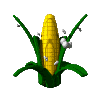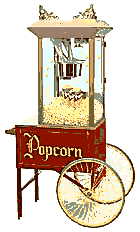![]()

The oldest ears of popcorn ever found were discovered in the Bat Cave of west central New Mexico in 1948 and 1950. Ranging from smaller than a penny to about 2 inches. The oldest Bat Cave ears are about 5,600 years old. Here, Cachise Indians dating back to 2,500 B.C., are thought to have grown and eaten popcorn. A funeral urn also found in Mexico from 300 A.D. shows a picture of a maize god with some form of primitive popcorn headdress. Popcorn kernels have also been found in tombs on the east coast of Peru, some of which still pop after 1,000 years.


The oldest known corn pollen is scarcely distinguishable from modern corn pollen, judging by the 80,000-year-old fossil found 200 feet below Mexico City.
It is believed that the first use of wild and early cultivated corn was popping.

Ancient popcorn poppers -- shallow vessels with a hole on the top, a single handle sometimes decorated with a sculptured motif such as a cat, and sometimes decorated with printed motifs all over the vessel -- have been found on the north coast of Peru and date back to the pre-Incan Mohican Culture of about 300 A.D.
Most popcorn from 800 years ago was tough and slender-stalked. The kernels themselves were quite resilient. Even today, winds sometimes blow desert sands from ancient burials, exposing kernels of popped corn that look fresh and white but are many centuries old.
![]()
![]()
![]()
![]()
![]()
![]()
![]()
![]()
![]()
Some Interesting History Facts:


![]()
When Columbus first arrived in the West Indies he found the natives both eating
and using popcorn as decoration. After invading Mexico in 1519, Cortes
discovered that popcorn was just as important to the Aztecs, who used it for
decorating their ceremonial headdresses and necklaces, as well as for food.
Recent Popcorn History

Popcorn was very popular from the 1890s until the Great Depression. Street
vendors used to follow the crowds, pushing steam or gas-powered poppers through
fairs, parks and expositions. At 5 or 10 cents a bag, popcorn was one of the few
luxuries that poor Depression families could afford. While other businesses
failed, the popcorn business thrived. An Oklahoma banker who went broke when his
bank failed bought a popcorn machine and started a business in a small store
near a theater. After a couple years, his popcorn business made enough money to
buy back three of the farms he'd lost.
Popcorn sales slumped during the early 1950s when television became popular.
Attendance at movie theaters dropped and, with it, popcorn consumption. When the
public began eating popcorn at home, the new relationship between television and
popcorn led to its resurgence in popularity.
Americans today consume 17.3 billion quarts of popped popcorn each year. The average American eats about 68 quarts.